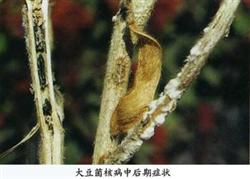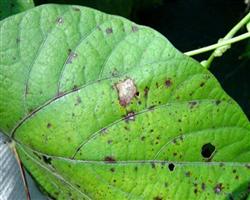Production technology of drought-resistant and early-maturing summer hoe for soybean

First, to replenish water and increase soil moisture, to promote the shade of seeds and the growth of soybeans, we should actively develop water-saving irrigation and maximize the drought resistance of water-saving irrigation facilities. On the one hand, we should actively tap water sources, drill more make-up wells, and improve the capacity of water supply; on the other hand, we should use water scientifically and save water, do everything possible to make full use of existing water sources, drought-resistant appliances and facilities, and adopt ditches on the side of ridges and platforms, filter water and irrigate them. Shallow cover soil, to achieve overnight suppression method to take water replenishment measures as soon as possible. Second, quickly carry out field inspection and replanting and ensure that field inspection work should be carried out quickly after sowing. Soil moisture should be checked 3-5 days after sowing, and corresponding measures should be taken to replenish soil moisture in plots with serious loss of soil moisture. Check the situation of buds before emergence and replant the dry buds and bad seeds in time. Check the seedling situation and insect situation after emergence, and timely replant precocious varieties or chemical control for the plots with uneven emergence, uneven lack of seedling broken strips or insect pests. 1. Replanting. It is best to replant kidney beans, adzuki beans, black beans and other crops with higher economic benefits, and early-maturing varieties with a short growth period of 10 to 15 days can be selected when replanting similar crops. 2. For the plots with late sowing time, dry teeth and bad seeds caused by low temperature and drought, especially serious lack of seedlings in the field and need to destroy seeds, early-maturing varieties or alternative crops should be selected, seed destruction should be resolutely adopted, and close planting should be adopted. make full use of effective accumulated temperature to increase the yield of destroyed crops. Third, pay close attention to deep loosening, shoveling, and make every effort to resist drought, preserve soil moisture and promote early maturity. 1. Deep loosening of ridges and furrows or ploughing before shoveling. After the soybean cotyledon arch soil, it is necessary to immediately carry out deep loosening of ridges with a depth of 20 to 25 centimeters, which is generally at 25 to 30 centimeters, which can loosen the soil, release cold and increase temperature, so as to promote the early growth and rapid development of bean seedlings, and realize the evenness and strength of seedlings. At the same time, it can enhance the water storage capacity of the soil, reduce the evaporation of water in the soil, and achieve the purpose of drought resistance and soil moisture conservation. For those without deep loosening conditions, the method of ploughing before shovel can also be used. 2. Strengthen the cultivation of soil by ploughing. It is very important to fight drought, promote early maturity, shovel early and manage early. During the whole growth period of soybean, we should strive to achieve three shovels and three times. The depth of mid-tillage should be carried out with the growth of root system from deep to shallow, and along with weeding, we should embrace to the root and gradually cultivate soil ridges to facilitate drought resistance and lodging resistance. The first time was carried out after the emergence of soybean seedlings to before the expansion of the first compound leaf, after shoveling, the depth was 10 cm 12 cm, the second time was 10 days from the first intertillage and the height of soybean seedlings was about 10 cm, and the depth was 8 cm 10 cm. The third time was 10 days from the second intertillage, and the wading was finished before the soybean ridge was sealed, the depth of the wade was 7 cm 8 cm, and the soil cultivation should reach the first compound leaf node. In addition, in the late growth stage of soybean, the weeds were pulled up once before the formation of grass seeds in the first ten days of August. Fourth, choosing safe, economical and efficient herbicides to deal with grass shortage after seedling is the great enemy of soybean production. If it is not cleared in time, the yield of soybean will be seriously affected. Therefore, for those who do not carry out chemical weeding or soil closure treatment before seedling, the weeds should be controlled at 2-3 compound leaf stage and 2-leaf 4-leaf stage after soybean emergence, using 5% refined grass EC 900-1500 ml per hectare, or 750-1000 ml EC with 15% stability, or 450 ml with 10.8% high-efficiency cauliflower EC, or 750 ml with 6.9% Weiba concentrated EC. Or use 12.5% to clean EC 1250-1500 ml, spray 450 kg of water. To control broad-leaved weeds, use 25% fomesafen 1000-1500 ml per hectare, or 450 ml of 24% ketoprofen EC, or use 24% weed incinerator 1000-1500 ml, spray 450 kg of water. Fifth, look at the seedling topdressing, accelerate the growth process of soybean, and promote the early growth of soybean due to low temperature and continuous drought in the early spring sowing stage. Topdressing should be applied in time to supplement crop nutrition, promote growth and development and improve stress resistance. Topdressing should be timely and early to prevent de-fertilization, especially the application of potassium fertilizer, can increase crop yield, improve quality, strong stalk, disease resistance, promote precocious effect. In the topdressing of nitrogen fertilizer, the amount of application should not be too large, and the period of topdressing should not be too late to prevent greedy green late ripening. 1. Topdressing in rhizosphere. It should be carried out before 2 times of shoveling, applying 45,75 kilograms of urea per hectare, and ploughing and cultivating soil immediately after topdressing. 2. Foliar topdressing. The first time was carried out at the first flowering stage of soybean, twice, once at the initial flowering stage and once at the initial stage of grain filling, and was sprayed with urea 10 kg plus potassium dihydrogen phosphate 1.5 kg in 500 kg water per hectare. Some drought-resistant and ripening-promoting nutrients mainly composed of humic acid and amino acids can also be sprayed according to local conditions. Sixth, carrying out scientific and timely irrigation to ensure high yield and stable yield of soybean in the branching stage, flowering and pod stage and grain filling stage is an effective measure to solve drought and ensure high yield of soybean. Where there are conditions, timely irrigation should be carried out according to the drought situation at that time and the law of water demand for the growth and development of soybean. Vigorously popularize water-saving irrigation techniques, such as sprinkler irrigation, etc., generally sprinkler water is: branch to flowering stage 30mm, flowering to podding stage 30~40mm, pod filling stage 30~35mm, sprinkler irrigation intensity should be less than soil infiltration rate, on the principle that the surface does not produce runoff, do not destroy soil structure, surface non-consolidation as the principle, no leakage spray, repetition 100~200mm. 7. Strengthen the prediction and forecast of diseases and insect pests and carry out comprehensive prevention and control of diseases and insect pests in the northern and eastern regions of Heilongjiang Province in time. The phenomenon of continuous cropping is relatively common, which leads to serious occurrence of diseases and insect pests. Therefore, all localities should do a good job in forecasting and preparing, and guide prevention and control in a timely manner to ensure the improvement of soybean quality and high yield. 1. Aphids. When the leaf-rolling rate of 510% of the plants reached 50%, the number of aphids of 100 plants reached more than 1500, and when the number of natural enemies was very small, 35% Sedan EC was used for 1000 ml per hectare, or 10% imidacloprid was used for 1500 grams, or 22 bags per hectare were used with 450 million 500 kg of water. 2. Red spider. When it is found in the field, use 35% Sedan EC 1000-1500 ml per hectare, or use 1.8% avermectin preparation or mixture 150 ml, spray 450-500 kg of water. 3. Soybean heart borer. When the insect feeding rate reached more than 5% in the previous year, the control target was reached. Poison sticks were made with 80% dichlorvos EC 1500-2000 ml per hectare, 1 row every 4 ridges, 1 root per 5 meters, or constant spraying of pyrethroids pesticides. 4. Meadow borer. When the occurrence of meadow borer reaches 1 per plant, pyrethroids can be sprayed with 225 to 300 milliliters per hectare. 5. Disease control. For soybean gray leaf spot, downy mildew and other fungal diseases, 70% methyl thiophanate wettable powder 1000 times solution or 50% carbendazim gel suspension 5000 times solution can be used to control Sclerotinia sclerotiorum. Sclerotinia sclerotiorum can be sprayed 1500 times at an interval of 7 to 10 days.
- Prev

Matching techniques of close planting in three rows of narrow trenches on ridges of soybean
The matching technology of close planting of three rows of narrow furrows on soybean ridges is a set of new soybean cultivation model independently developed by agricultural scientists and technicians in the reclamation area, and passed the appraisal of scientific research achievements of Inner Mongolia Science and Technology Department in December 2005. This technology has reached the advanced level of soybean cultivation technology in similar areas in China as a whole, and it is reasonable and close planting in mechanization.
- Next

Control techniques of Soybean Gray Leaf spot
1. Disease: mainly harms the leaves at the adult stage, and infects seeds, seedlings, stems and pods. Round brown spots appeared on the cotyledons of young seedlings born with diseased grains. Irregular plaques may also be formed in the later stage. When it is wet, the central part of the disease spot on the back of the leaf is full of gray mildew layer, which is the conidia of the pathogen. 2. Prevention and control methods:.
Related
- The first cup of black tea in spring, the flavor and history of tea gardens in Kenya, Africa
- The computer can not only choose potatoes, but also grow tea rice. AI will grow winter oolong tea champion.
- It is not only the inflated tea bitten by insects, but also engraved with the four seasons tea in Beipu.
- The Oriental Beauty Tea Festival in Zhuxian County takes the stage at the weekend to experience the plus-size feast of oil tea.
- & quot; Oriental Beauty Tea & Exploration of Emei in Hsinchu, the hometown of quot;
- The new variety of strawberry "Tainong 1" dessert is the first choice with mellow aroma. Crimson gorgeous
- History of Tea in Taiwan: from Wild Inner Mountain to Export Tea Garden
- Two types of Taiwan Oriental Beauty Black Tea won the British three-Star Award for Childhood Tea Xiang Zhang Jiaqi changed from pilot to champion tea maker.
- Banana species and varieties: the planting history of Taiwan Xianren banana and dwarf banana is long, is banana disease resistant?
- Coffee planting Technology: Qianjie Coffee from Seedling to harvesting

